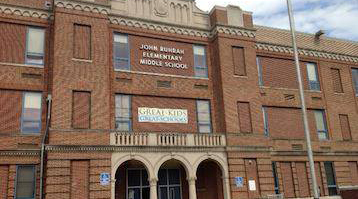He was an early 1900s pediatrician who developed the first soy-based baby formula, served as president of the American Pediatric Society, and extensively researched polio, a disease he would contract in his old age.
One hundred years later, the name “John Ruhrah” belongs to a Greektown elementary and middle school, remaining connected to kids, diverse and happily boisterous as they traipse to and from school and periodic neighborhood events such as tree-plantings or drain-stencilings.
“We’re not just a school that’s a factory where we bring kids in, go through instruction, and let them out,” said Margie Hatch, who began her work as community school coordinator at John Ruhrah Elementary and Middle School Aug. 1.
“The school is already doing a lot of the things a community school aims to do,” she said.
Known as a positive force in the neighborhood and a haven of sorts for the many immigrant parents whose children go there, Ruhrah is at a staggering 188 percent of student capacity while posting an astonishing staff turnover of zero.
Hatch’s position – she works full time at the school and is an employee of the Southeast Community Development Corp. – designates Ruhrah as one of the newest of Baltimore’s nearly 60 Community Schools, a program facilitated by the Family League of Baltimore in partnership with Baltimore City Public Schools and the city itself.
A community school coordinator, per the Family League web site, “develops partnerships with local community organization to create an environment where academics, enrichment, health and social supports, family engagement, youth and community development improve student well-being.”
The elements are all there; Hatch will assist in bringing them together.
“There’s a lot going on all the time,” she said, noting that parental involvement is particularly high.
“What makes this school really unique is parents are able to be present throughout the day, and not just because they have a meeting with a teacher or administrator,” she said.
The dynamic renders Ruhrah a sort of hub for the community, an event location where families can be found even during off school hours.
Hatch is implementing a two-year action plan to improve or enhance the school’s performance in several key areas, including parent involvement.
“We have parents that show up to events, and that’s great,” she said. “The next step is parent leadership. It would be great if they could get involved in our PTA organization, volunteer at the food bank, help at school events and even train new parents coming into the school.”
With a large immigrant population, Hatch will concentrate her efforts in that area as well, improving families’ access to immigration and legal services as well as English language learning for both parents and children.
A large part of Hatch’s role is connecting families with available services. Johns Hopkins Central SOL, an organization dedicated specifically to Latino health and mental health, already periodically visits the school to offer blood pressure checks, vision tests and other screening services.
“I’d like to get them in the building more often,” Hatch said.
Likewise, partnerships with Hope Health Services and Baltimore City Public Schools’ Newcomer Project will support students’ and parents’ mental health, the latter organization focusing on those who arrived unaccompanied in the U.S.
Sometimes, Hatch acknowledged, it’s just about having fun. Every Community School has a designated out-of-school-time partner, and at Ruhrah, Education Based Latino Outreach will occupy children in kindergarten through grade 5 with its Mi Segunda Casa program.
Soccer Without Borders, which offers tutoring and homework help as well as athletics, will be there for the older kids.
For those families ready to make the next step, the publisher Houghton Mifflin Harcourt has chosen Ruhrah as a pilot school for its Family Engagement workshop series.
“The idea is if we provide training for parents, they can be more engaged in their children’s education and improve outcomes,” Hatch said, adding that there will likely be 90 participants in the program, dedicated to English language learners.
At least one student and one parent would attend from each participating family. Topics include the school’s expectations, learning to be a good students, home support, preparing students for assessments and technology as a learning tool.
On top of everything else she is trying to accomplish, Hatch has a biggie. This school year is the last before students are moved out of the building – location yet to be determined – for at least two years, while Ruhrah is rebuilt under the city’s 21st Century Schools plan, increasing capacity and updating the facility.
“I hope during the process we can make parents feel more connected to the school, so they stay connected when the school moves,” Hatch said.
